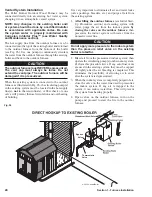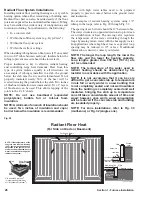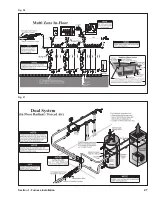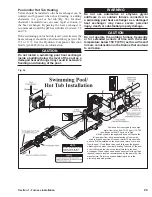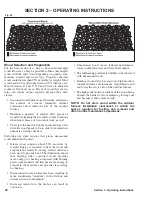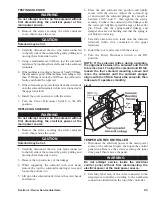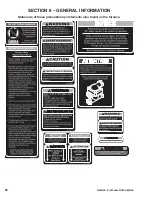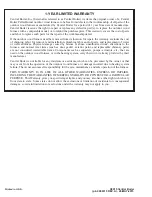
38
Section 3 - Maintenance Instructions
4. Inspect the door casting and heat shields. If the door
casting is not cracked through or broken, allowing
air to leak in, the door casting should not need to
be replaced. Like the damper, it is normal for heat
shields to show wear over time. The heat shield
should be replaced if it is no longer providing
coverage of the casting beneath the heat shield.
NOTE: If the outdoor furnace has been improperly
operated with the door partially open, close the
door and allow the outdoor furnace to cycle
normally for 1 hour before inspecting the door
for proper sealing.
3-6. Chimney
NOTE: Creosote is an accumulation of combustion
by-products on the surfaces of wood-burning
appliances. Twice a month during the heating
season, inspect for excessive creosote buildup
on the firebox walls, flue and chimney. If present,
the buildup should be removed for proper
operation and fire safety. Creosote, if ignited in
the chimney, results in an extremely hot chimney
fire. In case of a chimney fire, close the firebox
door.
1. If the flue passageway behind the baffle becomes
plugged, it must be cleaned.
2. Inspect the chimney for excessive buildup of
creosote and clean, if necessary.
3-7. Completely Remove Ash
1. Remove all ashes from the firebox.
CAUTION
Always wear the appropriate personal protective
gear when cleaning ashes from the firebox.
2. Use a wire brush and small scraper to clean the
firebox, side walls, back wall and ash pan. Use a
light to inspect for corrosion. If corrosion is present,
contact your dealer. Lubricate the solenoid plunger
with a light petroleum distillate (e.g., WD-40 or
equivalent).
2. Disposal of ashes - Place ashes in a metal container
with a tight-fitting metal lid. It can take many days
before the ashes are completely cooled. Other waste
should not be placed in this container.
3. Each time the ashes are cleaned out, inspect the
door rope (see Section 3-5) to make sure it is sealing
properly.
WARNING
When cleaning the outdoor furnace, be careful not
to spill any hot ash outside of the noncombustible
container.
3-8. Scrape Bottom of Firebox
Scrape the bottom 12 inches of the firebox clean. Allow
the fire to get very low; then move the coals to one
side of the firebox. Use a hoe to clean the other side.
Move the coals to the other side and finish cleaning the
firebox, leaving some ashes with the live coals. Pull the
coals and ashes to the draft area (front and center of the
firebox). When the furnace is filled, the coals remaining
in the firebox will light the fire.
NOTE: Regular cleaning of the firebox, particularly
at the ash line and below, reduces the possibility
of corrosion.
The top of the firebox and walls of the firebox above
the ash line should be scraped clean if large, thick, dry
or crusty deposits are present. A thin, tar-like layer of
creosote does not cause any problems in the operation
of the furnace.
3-9. Door Handle
Lubricate the door handle with a light petroleum
distillate (e.g., WD-40 or equivalent).
3-10. Auxiliary Burner
Periodically during the heating season (according to the
burner manufacturer's instructions), and at the end of the
heating season, the burner should be inspected, cleaned
and adjusted (as necessary). Failure to properly maintain
the burner may result in inefficient operation. After any
maintenance, be sure to install and secure the burner
cover to keep the burner and controls from exposure to
the elements. Refer to the burner's instructions for all
maintenance items and adjustments.

